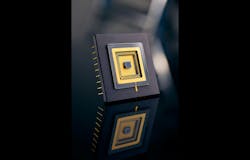Single-photon avalanche diodes meet embedded intelligence
Singular Photonics traces its origin to the pioneering work of Professor Robert Henderson, whose research at the University of Edinburgh helped lay the foundation for modern SPAD imaging. His early breakthroughs integrating SPADs into complementary metal-oxide semiconductors (CMOS) and creating time-of-flight autofocus sensors reshaped consumer imaging with designs that have shipped in more than a billion smartphones. Despite these advances, Henderson saw an opportunity to address a gap within the market. While SPAD sensors could count photons with unmatched sensitivity, they lacked the embedded intelligence necessary to support next-generation applications.
Singular Photonics was founded to address this gap—and we transform SPADs from passive detectors into active imaging engines that make sense of data in real time.
Why SPADs, why now?
SPADs detect individual photons through an “avalanche effect.” A single photon triggers a self-sustaining avalanche of photoelectrons, which are easily converted into a digital pulse with subnanosecond timing resolution. It makes SPADs invaluable for applications that require extreme sensitivity, whether for low-light imaging, resolving ultrafast phenomena, or working on the edge of quantum limits.
Historically, SPAD sensors were primarily research tools, constrained by simple outputs and reliant on the need for external processing. We recognized the real SPAD opportunity is transforming these captured signals into actionable insights at the sensor level itself. Embedding computational intelligence directly onto the sensor allows real-time interpretation, reduces power consumption, and opens up entirely new application spaces.
Advances in CMOS fabrication techniques enable high-density SPAD arrays to be manufactured cost effectively, while the evolution of the stacked process opened up another dimension for more integrated logic. The availability of these advanced SPAD sensors holds potential for LiDAR, medical imaging, advanced spectroscopy, and time-resolved industrial inspection.
Embedded intelligence at the pixel level
Traditional SPAD sensors operate by detecting photons, converting them into digital pulses, and transmitting these signals to external electronics for processing. This approach increases system complexity, data bandwidth requirements, and power consumption. We address these issues by embedding computation directly into the sensor architecture itself.
By using a three-dimensional (3D) stacking strategy that places millions of logic transistors beneath the SPAD detector layer, we increase the photon detection area and enable real-time tasks such as histogramming (correlation analysis) to be calculated beneath the pixel where the photons arrive. By reducing the volume of raw data that must be transmitted and processed downstream, the architecture enables faster, more energy-efficient imaging systems.
For end users, tasks that previously required external computing hardware, such as photon correlation for flow measurements or lifetime analysis for microscopy, can now be handled within the sensor. The result is reduced latency, simplified system design, and the ability to deploy high-performance photon-counting systems within power- or size-constrained environments.
Differentiation in a competitive landscape
SPAD technology is attracting attention from both established imaging giants and startups. We focus on differentiation in three key areas: Computational intelligence, manufacturing scalability, and multimodal capabilities.
Rather than operating the SPAD as a simple photon counter, Singular designs sensors that can perform significant processing on-chip and feature an architecture that allows for dynamic mode switching. By using standard CMOS processes combined with advanced 3D integration, our sensors are scalable for commercial production—without the cost and yield issues that can limit other sensor technologies.
By processing data at the sensor level, we also reduce the need for power-hungry external computation, which enables new classes of edge devices such as portable medical instruments, wearables, and autonomous machines operating on limited power budgets.
A multisensor product portfolio
From the outset, Singular chose to build a portfolio aligned with distinct application sectors. Our first product, Sirona, is focused on the life sciences market, and is a SPAD line sensor optimized for time-resolved Raman spectroscopy, fluorescence lifetime imaging, and time-correlated single-photon counting (TCSPC). Each pixel includes dual SPAD detectors, which enables multispectral or beam-scanning operation, while on-chip histogramming provides advantages for research and medical diagnostic systems.
Our second product, Andarta, was designed in collaboration with Meta as a method to monitor cerebral blood flow. The sensor delivers subnanosecond timing performance with integrated on-chip autocorrelation to enable high frame rates and robust operation within low-light conditions. It is designed for diffuse correlation spectroscopy (DCS) applications, which demand extreme sensitivity and timing accuracy.
At the 2025 Laser World of Photonics Congress in Munich, we demonstrated how our Andarta sensor enables real-time DCS to detect blood flow changes through tissue—without a single needle, contact pad, or delay. The live setup demonstrated how the sensor captures real-time microvascular dynamics to track pulsatile blood flow at the fingertip in real time and resolves subtle changes in perfusion with high temporal resolution. All processing was performed on-chip, with real-time autocorrelation computation of blood cell motion.
Our upcoming Litavis sensor is the next leap: Multimodal SPAD sensing with configurable histogram modes and embedded inference will enable autonomous photon-driven decision-making for robotics, machine vision, and beyond.
Wide range of applications
Singular Photonics’ technology has immediate relevance in biomedical imaging, industrial automation, scientific, and quantum technologies. In healthcare, the Andarta sensor enables wearable systems that use DCS to deliver monitoring capabilities in neurology, intensive care, and rehabilitation, while Sirona is being used in Raman and fluorescence lifetime spectroscopy systems for faster and more sensitive biomolecular analysis.
In flow cytometry, rapid, precise photon counting enables more sensitive biomolecular assays and refined cell sorting. Beyond life sciences, the unmatched single-photon sensitivity and timing accuracy of SPAD sensors are opening new possibilities in quantum communications and computing—from entanglement experiments to secure quantum key distribution. Emerging machine vision markets, from industrial automation to robotic navigation in challenging light or motion conditions, are also showing strong demand for these capabilities.
Shaping the future of intelligent optical sensing
Singular is shaping the future of intelligent SPAD technology, with developments underway to take performance, versatility, and integration to entirely new levels. Even more exciting advances are on the horizon—innovations we can’t yet reveal but show promise to push the boundaries of what’s possible in photon-based sensing.
With our sensors already in the field and more forthcoming, we’re busy shaping the future of intelligent optical sensing to redefine how machines perceive and interact with the world—photon by photon.
About the Author

Shahida Imani
Shahida Imani is CEO of Singular Photonics (Edinburgh, U.K.). A Chartered Management Accountant, Shahida has worked for number of high-tech companies such as Chromacity, Optos, Voxar, and Odos Imaging, bringing expertise in scale-up and international expansion.
